#pseudocyphellaria
Explore tagged Tumblr posts
Text
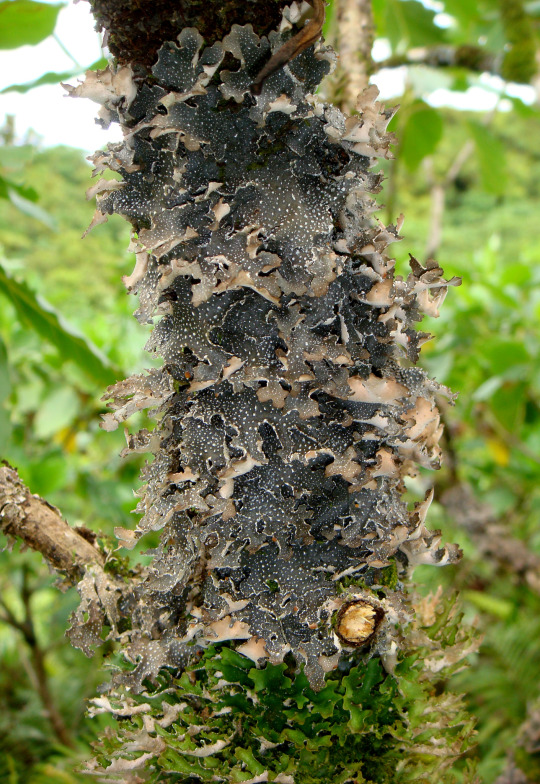
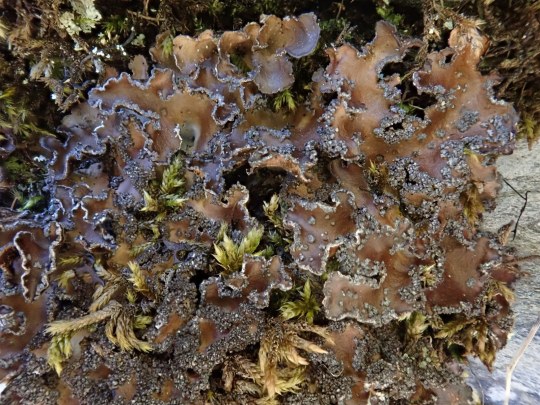
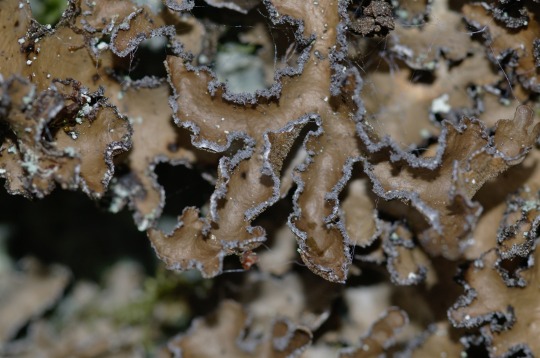
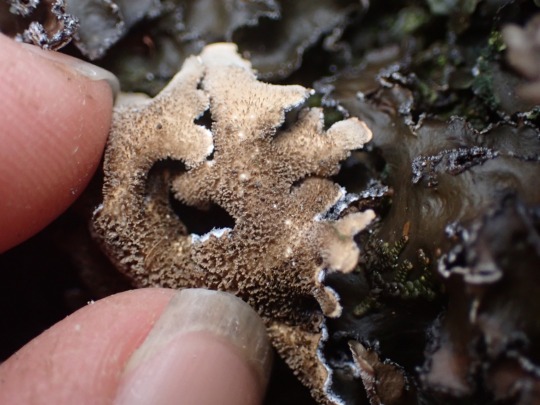
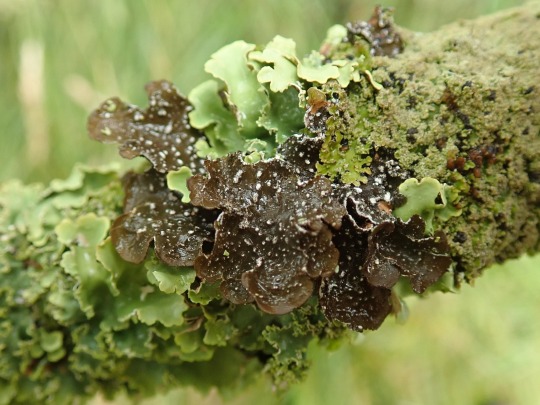
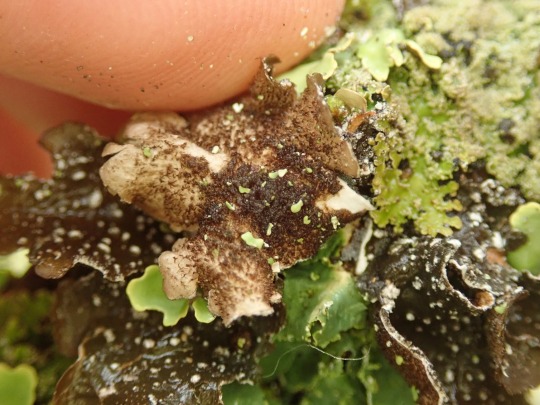
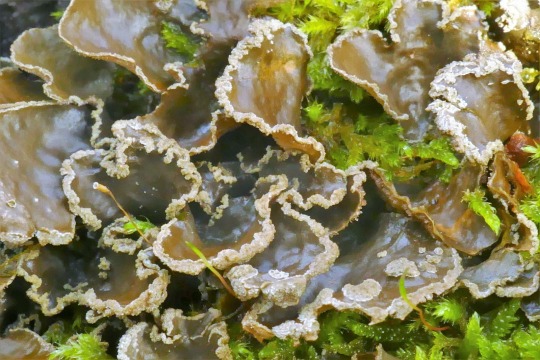
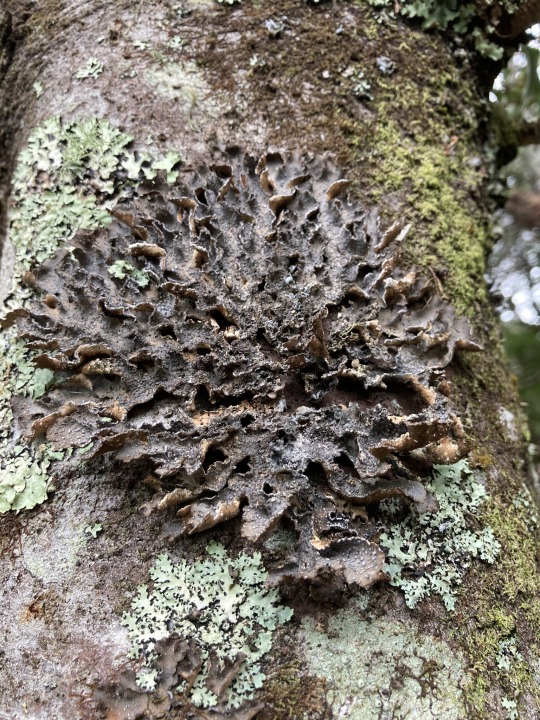

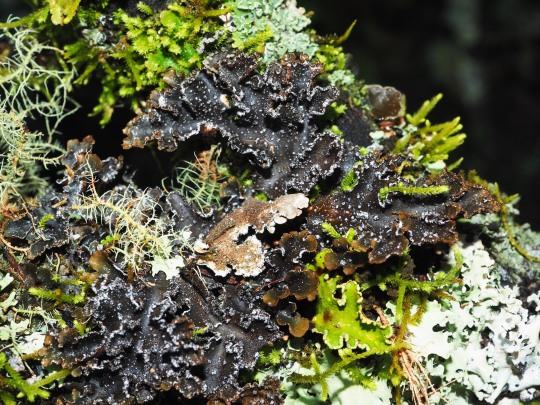
Pseudocyphellaria intricata
The rare or endangered species that get the most attention are often the most adorable or charismatic, and humans tend to like things that we can recognize some bit of ourself in. So in that sense, I get why lichens don't get all that much attention. But my goodness, when I look at P. intricata, it looks like a starry night sky or the billowing, cosmic clouds of a nebula or some inexplicably vast yet minute and mysterious galaxy, and I am gazing at in wonder and feeling my own insignificance, and damn if that doesn't make me want to protect it, too. This large, foliose cyanolichen has loosely attached lobes which grow in rosettes or extensive patches up to 20 cm in diameter. The lobes have incised margins covered in a layer of blue-gray soredia, which often spread across the thallus is scattered dots or squiggly lines. The upper surface is gray-brown when moist, red-brown when dry, and the lower surface is beige and tomentose, with scattered pseudocyphella (tiny sunken bald patches). Like many old-growth forest species, populations of P. intricata are on the decline as the humid, costal woodlands it resides in are becoming a thing of the past due to logging, pollution, and climate change. And that makes me sad for a lot of reasons I can't articulate, but so much of it has to do with the destruction of the majestic and wonderful and diverse things of the world in favor of the ordinary and the temporary and the mundane. I don't really know what to do about it, but I think if more of us cared about the tiny infinities growing in the forests, that would be a start, you know?
images: source
info: source | source | source
#lichen#lichens#lichenology#lichenologist#mycology#ecology#conservation biology#biology#endangered species#symbiosis#symbiotic organisms#cyanobacteria#fungus#fungi#Pseudocyphellaria intricata#Pseudocyphellaria#trypo#trypophobia#life science#environmental science#natural science#nature#forest#see the forest for the lichens#I'm lichen it#lichen a day#daily lichen post#lichen subscribe#beautiful nature#weird nature
148 notes
·
View notes
Text

Out on a little pre-work lichen hunt this morning. A distinguished lichenologist once found yellow specklebelly lichens somewhere near here. That was in 1977. Maybe the spruce and rhododendrons have done the specklebellies in, or maybe I just need to look harder. This view makes it seem like I picked the wrong side of the loch entirely, though.
96 notes
·
View notes
Text
#2454 - Pseudocyphellaria sp. - Specklebelly Lichens

Another specklebelly lichen, but i'm not sure which species this one is. As you can see the treetrunk was absolutely encrusted with other species - I really could have spent hours on one tree, finding more species to photograph.
Taranaki Goblin Forest, New Zealand
7 notes
·
View notes
Text





Lichen of a hike I went on two weeks ago
In order:
Pink earth lichen, Dibaeis arcuata
Coral lichen, Pulchrocladia retipora
Coral lichen again but a different morphotype
Pseudocyphellaria glabra
Pseudocyphellaria sp.
30 notes
·
View notes
Text

#pseudocyphellaria rainierensis#pseudocyphellaria#lichen#deception creek#king county#washington#nikon d40
4 notes
·
View notes
Photo

my favourite thing is scientific article titles that read like clickbait
P.S. there’s full text available on ResearchGate
#lichen#lichens#lichenology#science#Pseudocyphellaria#Pseudocyphellaria crocata#I'll do a lil summary of this one for y'all once I read it
411 notes
·
View notes
Text

Pseudocyphellaria rainierensis lichen on a mossy tree
#moss#cottagecore#goblincore#forestcore#exploring#nature photography#lichen#gremlincore#biology#botany#plant sciences
50 notes
·
View notes
Photo









first row: Psora decipiens, a very cute pastel squamulose lad with a pink center and white isidia around the edges. in my opinion these are best viewed under a dissecting microscope, where you can see all the details of the fading between the pink and white sections.
second row, left: Ramalina menziesii, the lace lichen and the state lichen of california. very cool lad who grows in HUGE tufts hanging off branches.
second row, right: Lobaria pulmonaria, aka ‘lungwort’, known for covering WHOLE ASS TREES and unsurprisingly one of the fastest growing lichens.
third row, left: an example of the large lichen genus Cladonia; Cladonia fimbriata, specifically. this genus is responsible for most of the lichens I see people getting confused about in general, and i’ve found this is because theyre just...kind of hard to make sense of if you’re unacquainted, especially if you’re like, wandering in the woods and encounter a group of Surprise Cup Lads (LICHEN PRO TIP: when you see a lichen making little cups on stalks, something from Cladonia is a solid guess in terms of ID). the genus is huge and incredibly diverse, and they all come in different shapes, sizes, colors, and growth forms, which makes them even more endlessly entertaining. when i first learned about these guys i spent a couple hours just looking through my uni’s herbarium; Cladonia, as a genus, fills half a locker of samples in the lichen section (that is...a LOT of lichens).
third row, right: Usnea cirrosa. i have never seen this species with my own eyes. i’ve seen other species of Usnea, which look comparatively normal, but i have never seen this particular one outside of the lichen textbook where i saw this exact same picture and could not handle it. this is one of those times where i just do not know what happened here in terms of evolution. apparently it lives in texas
fourth row, right: Pseudocyphellaria anthraspis (aka Lobaria anthraspis). the pic is one i took of a sample i collected in northern california, near a redwood forest. i just think shes neat
fourth row, left: Rhizocarpon lecanorinum. this one’s a smaller sample photographed by Annelie Burghause on Flickr. we use this species in class as an example of a lichen that can be identified by what color it glows under UV light; this one turns orange, which indicates rhizocarpic acid in the thallus.
there are probably a ton im forgetting bc there are a LOT i like but these are some that come to mind lmao
#credits for the pics i dont directly credit are under the respective CNALH links#plont asks#asks#lichens
496 notes
·
View notes
Text
Some fun stuff on the intense lichen and moss biodiversity in the old-growth cedar and hemlock stands of the inland temperate rainforest region.


We report our initial findings of 39 lichen taxa, including several rare species and cyanolichens, which may be especially sensitive to climate. [...] Some of the world’s most famous temperate rainforests occur along the west coast of North America. A lesser known, but equally unique ecosystem is the inland temperate rainforest (ITR), which is predominantly located in British Columbia between 50° and 54°N. The ITR shares many characteristics with its coastal counterparts, including large diameter western redcedar (Thuja plicata), some speculated to be over 1000 years old (Radies et al. 2009), and a dense understorey of devil’s club (Oplopanax horridus). This ecosystem provides important habitat for many species, including the threatened mountain ecotype of woodland caribou, and many disjunct populations of characteristically coastal lichen species. Old-growth coniferous stands in the ITR support exceptionally rich epiphytic lichen communities, especially cyanolichens lichens that have a cyanobacterial photobiont as one of their symbiotic partners.
-----
From “Ecological Characteristics of Inland Rain Forests,” Andre Arsenault and Trevor Goward:
By their high ambient humidity, inland rain forests favour colonization by numerous oceanic species, that is, species more often associated with maritime environments. For example, hanging moss (Antitrichia curtipendula) forms thick hanging mats on the boughs of western redcedar (Thuja plicata) and western hemlock (Tsuga heterophylla) trees. A number of oceanic vascular species also occur here, including deer fern (Blechnum spicant) and red huckleberry (Vaccinium parviflorum). Perhaps most fully represented, however, are various oceanic epiphytic lichen genera, including Chaenotheca, Chaenothecopsis, Collema, Fuscopannaria, Lichinodium, Lobaria, Nephroma, Parmeliella, Polychidium, Pseudocyphellaria, Sphaerophorus, and Sticta. Many species belonging to these genera are old-growth-dependent in this portion of their range, and are rare or infrequent in British Columbia as a whole
-----

A University of Northern British Columbia press release from 2018:

In British Columbia, much of the research on plant biodiversity has focused on coastal and maritime ecosystems, especially coastal temperate rainforests. However, in B.C. there is a second temperate rainforest ecosystem, the inland temperate rainforest. It has received far less attention, both from the scientific community, and from the general public.
With the designation of the Ancient Forest/Chun T’oh Whudujut Provincial Park in 2016, a team of researchers jumped at the chance to do a detailed study of biodiversity in the inland rainforest located 115 km east of Prince George. Now, in their third year of field studies [...] these scientists have been astonished by what they have discovered. Collaborating with UBC botanists Trevor Goward and Curtis Björk, leading experts on rare plants, they have discovered more than 2,400 species in the Upper Fraser River Watershed, commonly called the Robson Valley. “This is an amazing total for such a small part of the province,” explains [Dr. Darwin] Coxson. “It includes many species that are new to this part of British Columbia and indeed Canada, and a surprisingly high number of species that will be new to science. This includes new species of mosses, lichens and vascular plants. This will be an exciting story for the scientific community in British Columbia.”
-----
9 notes
·
View notes
Text






Pseudocyphellaria freycinettii
images: source | source
#lichen#lichens#lichenology#lichenologist#mycology#ecology#biology#fungi#fungus#symbiosis#symbiotic organisms#algae#Pseudocyphellaria freycinettii#Pseudocyphellaria#life science#environmental science#natural science#nature#naturalist#beautiful nature#weird nature#the natural world#trypo#trypophobia#I'm lichen it#lichen a day#daily lichen post#lichen subscribe
71 notes
·
View notes
Video
Pseudocyphellaria anthraspis, SPECKLEBELLY LICHEN by alice cummings Via Flickr: Pseudocyphellaria anthraspis, SPECKLEBELLY LICHEN. A lichen with reddish apothecia and a white-speckled underside.
7 notes
·
View notes
Text
#2336 - Pseudocyphellaria faveolata - Honeycombed Specklebelly


AKA Crocodia cellulifera, Diphanosticta cellulifera, Lobaria billardierei var. cellulifera, Pseudocyphellaria cellulifera, Pseudocyphellaria condensata, Sticta billardierei var. cellulifera, Sticta cellulifera, Sticta condensata, Sticta elatior, Sticta fossulata var. cellulifera, Sticta faveolata, Sticta foveolata var. cellulifera, and Sticta lorifera. The fronds can be quite variable in size and shape, hence the proliferation of synonyms.
Found in New Zealand, SE Australia, Tasmania, and the southern end of South America. It grows on bark and twigs in windswept coastal scrub, lowland coastal forest, beech forest, mixed beech-podocarp forest, subalpine scrub close to or above treeline, and on successional vegetation in disturbed sites. Especially large and common in wet open forest habitats, close to margins of the forest. Intolerant of full shade.
Many species of Pseudocyphellaria are cyanolichens, containing the cyanobacterium Nostoc as a photobiont. This makes the lichens quite important in the nitrogen budget of their environment. Other species also contain the green alga Dictyochloropsis and restrict the Nostoc to warty gall-like structures on the lower surface of the lichen.
Some Pseudocyphellaria use either - P. murrayi and P. rufovirescens are actually the same fungus forming two very different lichens, one with a cyanobacterium and one with a green alga.
Many species of Pseudocyphellaria are restricted to old-growth forests in humid areas, and are therefore threatened by logging. Pseudocyphellaria crocata is severely threatened in Scandinavia, a development partly attributed to global warming and an attendant increase in grazing from snails.
Whakapapa Village, North Island Volcanic Plateau, New Zealand.
11 notes
·
View notes
Text
Some lichen from Waipohatu walking track, taken by me :))





In order:
Cladina mitis
Pseudocyphellaria fimbriata
Unspecified foliose species (I’m sorry I cannot tell)
Cladina confusa
Pseudocyphellaria sp.
EDIT: changed L. pulmanata to P. fimbriata after reviewing it, sorry about that.
16 notes
·
View notes
Text
Lichen secondary metabolite physciosporin decreases the stemness potential of colorectal cancer cells.
PMID: Biomolecules. 2019 Nov 28 ;9(12). Epub 2019 Nov 28. PMID: 31795147 Abstract Title: Lichen Secondary Metabolite Physciosporin Decreases the Stemness Potential of Colorectal Cancer Cells. Abstract: Secondary metabolites of lichens are promising bioresources for candidate anti-cancer drugs. Accordingly, several approaches have been proposed for screening these molecules for novel anti-cancer lead compounds. In this study, we found that a non-toxic concentration of physciosporin, a compound isolated from Pseudocyphellaria granulata, significantly decreased colony formation on soft agar and spheroid formation by CSC221 cancer stem-like cells. Physciosporin also decreased spheroid formation in other colorectal cancer cell lines, including DLD1, Caco2, and HT29. Aldehyde dehydrogenase-1 (ALDH1), the most important cancer stem marker, was sharply downregulated at both the protein and mRNA level following treatment with physciosporin. Physciosporin also decreased the transcriptional activity of the glioma-associated oncogene homolog zinc finger protein (Gli), as well as the Hes1 and CSL promoters, in reporter assays. Moreover, the drug significantly suppressed spheroid formation in CSC221 cells overexpressing Gli1/2 orEN1 (an S2-cleaved but membrane-tethered form of human Notch1) but did not suppress spheroid formation in cells overexpressing both Gli1/2 and ∆EN1, suggesting that physciosporin suppresses colon cancer cell stemness through the Sonic hedgehog and Notch signaling pathways. Together, these results demonstrate for the first time that physciosporin is a potent inhibitor of colorectal cancer cell stemness.
read more
0 notes
Text


Ph: Paula Nicole Pabón Localidad: Chapinero, Bogotá, Colombia Coordenadas geográficas: 4°38’59.35” N 74°02’53.72” O Fecha: 13/03/2017 ________________________________________
Nombre científico: Pseudocyphellaria crocata. Taxonomía: reino: Fungí; clase: Lecanoromycetes; familia: Lobariacae; genero: ; especie: Pseudocyphellaria crocata. Nombre común: Liquen Baya Salpicarado.
Descripción: Tallo folioso suelo, libre en los bordes tienen de 10 a 15 cm de ancho, con lóbulos de 0,5 a 2 cm de ancho, superficie superior más comúnmente de color marrón y suele tener manchas blancas dispersas e irregulares, su forma es irregular, se encuentra comúnmente en pastizales abiertos y utiliza sustratos como rocas o madera así como en arbustos, suele verse en habitad húmedos y sombreados. Se puede encontrar en regiones templadas y tropicales frescas, suelen ser muy sensibles a la contaminación por lo que han disminuido su población a causa de la industrialización y contaminación de los ecosistemas de los que depende, tanto para el aire como para la humedal y la calidad del sustrato en donde vive.
Distribución ecológica: En la región biogeográfica los Andes, así como la Sierra Nevada de Santa Marta con elevaciones de 2300 a 3750 m, se encuentra en departamentos colombianos como Boyacá, Nariño, Cauca, Huila, Magdalena, Norte de Santander, Quindío, Tolima y Cundinamarca. Estado de conservación: No evaluada, su origen: Nativa.
Datos curiosos: Es utilizado como indicador del estado del ecosistema en donde se encuentra, y al contener cianobacterias permite la fijación de nitrógeno, y depende del color del alga con el que se encuentre dará la especie, tiene gran cantidad de especies diferentes de esta gracias a los diversos colores de las algas con las que puede desarrollarse. En algunos lugares como Gran Bretaña se utilizan para producir colorante marrón y naranja-marrón, así como se han utilizado para teñir lana, también es utilizado como te para la digestión aunque su cuidado es extremo puesto que cuando tienen tonos amarillentos suelen ser por las estructuras que contienen ácido pulvinico siento está altamente toxica al ingerirla. ________________________________________ Fuentes http://conservancy.umn.edu/bitstream/handle/11299/158659/R9%20crocata.pdf;sequence=1 http://catalogoplantasdecolombia.unal.edu.co/es/resultados/especie/Pseudocyphellaria%20crocata/ http://www.revistas.unal.edu.co/index.php/actabiol/article/view/27491
0 notes
Text
Líquens: saiba mais


1. Líquens são a união entre uma alga ou cianobactéria e um fungo. Estas primeiras realizam fotossíntese; portanto, alimentam a união; já os fungos mantém a umidade do ambiente e são responsáveis pela reprodução.
2. Os líquens, assim como os musgos e as cianobactérias, preparam o terreno para outros animais e plantas. Também são ótimos indicadores biológicos, e podem ser usados na indústria de cosméticos e com fins antibióticos e antitumorais. Por fim, podem ajudar na determinação da idade de substratos, no monitoramento do aquecimento global e no biomonitoramento da qualidade do ar.
3. Alguns líquens presentes em Porto Alegre são: Teloschistes exilis (fruticoso) Cladonia sp. (dimórfico) Coenogonium sp. (filamentoso) Pseudocyphellaria aurata (folioso) Phyrrhospora haematites (crostoso) Phyllopsora breviuscula (esquamuloso)
0 notes